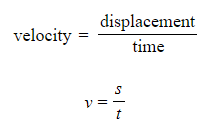Class 10 Exam > Class 10 Notes > Physics for GCSE/IGCSE > Speed & Velocity
Speed & Velocity | Physics for GCSE/IGCSE - Class 10 PDF Download
Speed
- The speed of an object represents the distance it covers in a specific amount of time. It is a scalar quantity, indicating magnitude without direction.
- Speed is a scalar quantity because it only contains a magnitude without a specific direction. For example, if a car is moving at 60 km/hr, the speed is 60 km/hr.
- For objects moving at a constant speed, the speed can be calculated using the formula:

- Where:
- Speed is measured in meters per second (m/s)
- Distance traveled is measured in meters (m)
- Time taken is measured in seconds (s)

Average Speed
In scenarios where an object's speed varies, possibly accelerating or decelerating, the average speed is calculated.
- In such cases, the object's speed fluctuates, leading to moments of acceleration and deceleration.
- The formula for determining average speed of an object is utilized:

- The formula for average speed (and speed) can be rearranged using the formula triangle provided below.
- The rearrangement of the formulas can be understood with the formula triangle illustrated.

How to Use Formula Triangles
Formula triangles are handy tools for rearranging physics equations effectively. Here's how you can use them:
- Cover up the quantity you want to calculate, known as the 'subject' of the equation.
- Observe the positions of the other two quantities:
- If they are on the same line, they are multiplied.
- If one quantity is above the other, they are divided - maintain the order for the fraction.
- In a practical scenario, consider calculating speed:
- Cover 'speed' and you are left with distance and time.
- Speed is then represented as distance (on the top) divided by time (on the bottom).
 How to use formula triangles
How to use formula triangles
Question for Speed & VelocityTry yourself: How is speed defined?View Solution
Velocity
- Velocity, akin to speed, indicates the rate of motion of an object, but it also specifies the direction of its movement.
- Speed, being a scalar quantity, solely encompasses magnitude without indicating direction.
- Consequently, velocity qualifies as a vector quantity due to its representation of both magnitude and direction.
- For instance, velocity could be expressed as '15 m/s south' or '250 mph on a bearing of 030°'.

- Velocity can have a negative value, for instance, when a ball is thrown upwards at 3 m/s, it comes down at -5 m/s if upwards is considered positive. Despite this, their speeds remain 3 m/s and 5 m/s, respectively.
- The equation for velocity closely resembles the equation for speed.

- Where
- v = velocity in meters per second (m/s)
- s = displacement, measured in meters (m)
- t = time, measured in seconds (s)
- Velocity is a vector quantity, utilizing displacement, s, instead of distance, which is scalar.
The document Speed & Velocity | Physics for GCSE/IGCSE - Class 10 is a part of the Class 10 Course Physics for GCSE/IGCSE.
All you need of Class 10 at this link: Class 10
|
129 videos|188 docs|35 tests
|
FAQs on Speed & Velocity - Physics for GCSE/IGCSE - Class 10
| 1. What is the difference between speed and velocity? |  |
Ans. Speed is a scalar quantity that measures how fast an object is moving, while velocity is a vector quantity that includes both the speed and direction of an object's motion.
| 2. How is average speed calculated? |  |
Ans. Average speed is calculated by dividing the total distance traveled by the total time taken to travel that distance.
| 3. Can an object have a high speed but zero velocity? |  |
Ans. Yes, an object can have a high speed but zero velocity if it is moving in a circular path or changing direction constantly.
| 4. How does acceleration relate to speed and velocity? |  |
Ans. Acceleration is the rate at which an object's velocity changes. It can affect both the speed and direction of an object's motion.
| 5. Why is it important to consider both speed and direction when discussing velocity? |  |
Ans. It is important to consider both speed and direction when discussing velocity because they together provide a complete description of an object's motion.
Related Searches




















